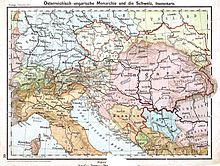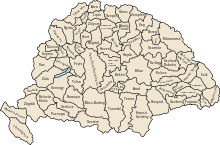Grand Duchy of Transylvania
The Grand Duchy of Transylvania ( Hungarian Erdélyi Nagy Fejedelemség , Romanian Marele Principat al Transilvaniei ) was a monarchy in what is now the Romanian region of Transylvania .
The Grand Duchy was founded in 1765 and from 1867 it belonged completely to the Kingdom of Hungary in legislative and administrative terms , but was still unofficially regarded as a separate geographical, demographic and cultural unit until the defeat of Austria-Hungary in the First World War in 1918. After the end of the war it was occupied and annexed by the Kingdom of Romania , which was sealed under international law in the Treaty of Trianon in 1920.
history
prehistory

During the Great Turkish War , the Habsburgs under Emperor Leopold I occupied the Principality of Transylvania , a vassal of the Ottoman Empire , and forced Prince Michael I. Apafi to place his empire under the rule of the Habsburg Empire . From 1687 on, the Prince of Transylvania paid tribute to the Austrian monarch, who bore the title of King of Hungary . After the death of Michael I. Apafi in 1690, Leopold with the Leopoldine diploma decreed that the Transylvanian area was inseparably associated with the Habsburg monarchy. Michael's son and heir Prince Michael II. Apafi finally renounced Transylvania in 1699 in favor of Leopold. The transfer to the Habsburg Empire was confirmed in the Treaty of Karlowitz between the Holy League and the Ottoman Empire in 1699 .
The membership of Transylvania and Hungary to the Habsburg Empire was controversial in parts of the local population, and the discontent erupted in 1703 in an uprising by the Hungarian nobleman Franz II. Rákóczi , which was suppressed in 1711.
In the Peace of Sathmar on April 29, 1711 between the Habsburgs and the rebels, Transylvania remained part of Austria, and the Viennese government managed to consolidate control over the area. In the same year the title of Prince of Transylvania was replaced by a governor , who in fact assumed the role of governor .
From 1734, Transylvania was the settlement area of the German-speaking Protestant peasants who lived under Charles VI. and Maria Theresa were deported from the Habsburg hereditary lands between 1734 and 1756 . It was the only area of the empire where Protestantism was tolerated.
Foundation and development until 1867
In 1765, on the initiative of Maria Theresa and her son Joseph II, the Grand Duchy of Transylvania was proclaimed, which had a special separate status within the Habsburg monarchy.
The majority of the population in Transylvania at the time of the Grand Duchy was Romanian. Many of the Romanians worked as farmers for Hungarian magnates under precarious conditions. Demands for political equality remained unsuccessful even after the Horea uprising in 1784.
During the liberal revolutions of 1848 called for the Hungarian insurgents during the Hungarian Revolution reunification of Transylvania with the Kingdom of Hungary , but were so unlike the Romanian Revolution , whose followers under the leadership of Avram Iancu to Transylvania and the abolition of the independence serfdom inserting . After the Hungarian uprising in 1849 was suppressed by Austria and Russia , the Grand Duchy remained under military administration for several years and was recognized by Austria in the March Constitution as a separate crown land , completely independent from Hungary.
In 1853 the Transylvanian military border , which had existed since 1762, was dissolved and reunited with Transylvania.
In 1866, the Magyar- dominated Parliament of Transylvania voted for the Grand Duchy to belong to Hungary. The union was carried out in January 1867 and confirmed with the subsequent Austro-Hungarian settlement . As a result, Szekler and the Transylvanian Saxons lost their centuries-old autonomous status and became subjects of the King of Hungary.
Part of the Kingdom of Hungary in Austria-Hungary

In 1868 the Grand Duchy of Transylvania with all of its autonomous institutions (including the state parliament) was finally dissolved. The Parliament met from now in Budapest. After a first period rather conciliatory gestures, such as the adoption of a liberal, tuned to the nationalities of Hungary, the Education Act 1868 by Culture Minister József Eötvös , the national policy of Hungary became more aggressive and resulted in a ruthless Magyarization . Contrary to the expectations of the royal government in Budapest , this policy strengthened the identity of the Romanians living there, who began to organize themselves in national associations of all kinds (sport, art, culture, finance). The Romanian side persisted in "passive resistance" until 1902, and at the beginning of the twentieth century also formed a determined political elite, including people like Iuliu Maniu and Alexandru Vaida-Voevod . It forced the Hungarian government under István Tisza with the Romanians twice (1910 and in 1913–1914) to negotiate more participation and autonomy in the region. In addition, the Magyars were confronted with the newly created state of Romania (independent since 1878 and kingdom in 1881 ). The kingdom was charged with claims to Transylvania, even if one could not speak of genuine irredentism .
In contrast to the Romanians, the Transylvanian Saxons, who had lost their privileges in 1876, made a compromise with Budapest in 1890, but resisted the Magyarization.
During the Austro-Hungarian era, Transylvania increasingly became the subject of negotiations between Austria and Hungary itself and Austria-Hungary with Romania. The nationalist movements in Romania that grew stronger in the 1880s raised all claims to Transylvania and regarded the area as the “third Romanian province” (with Wallachia and Moldova ). Hopes for state support were dashed when the country joined the Triple Alliance between Austria-Hungary, the German Empire and the Kingdom of Italy in 1883. At the beginning of the First World War , these forgotten hopes initially seemed to find little support. Romania remained neutral and began to negotiate with both sides and joined the Entente on August 17, 1916 . On August 27, Romania declared war on Austria-Hungary, and Romanian troops began to occupy Transylvania. The campaign ended after a few weeks with several defeats by the Romanians against Austro-Hungarian, German and Bulgarian troops. Romania was almost completely occupied by Austria-Hungary and peace was made with the country in May 1918 .
The last months of the war led to bloody clashes in Transylvania between Hungarian ultra-nationalist associations and pro-Romanian separatists. Some prominent Romanian politicians and personalities from the area fled to Romania and in June 1917 formed their own legion within the Romanian army, which fought on the Entente side until the end of the war.
On October 31, 1918, Hungary declared its exit from the Realunion with the Austrian Empire, and Austria-Hungary ended. Transylvania remained part of Hungary until November 1918 and declared its union with Romania on December 1st.
Politics and administration
The Grand Duchy of Transylvania has been part of the Hungarian Crown since its foundation in 1765 and a crown land of the Austrian Empire from 1804 . Since the February patent in 1860, the country was a constitutional monarchy with its own elected state parliament .
Administrative division
The Grand Duchy had been divided into 15 counties since 1876 (instead of the previous division according to ethnic boundaries: Land of Hungarians in the southeast and small districts in the center, Land of Saxons in the west and the center and Land of the Szekler in the south and north) :
- Alsó-Fehér (Unterweissenburg),
- Besztercze-Naszód (Bistritz-Naszód),
- Brassó (Kronstadt)
- Fogaras
- Szilágy
- Háromszék
- Hunyad
- Kolosz ( Cluj-Napoca ),
- Kis-Küküllö (Kleinkokelburg),
- Nagy-Küküllö ( Großkokelburg ),
- Szeben (Sibiu),
- Maros-Torda
- Szolnok-Doboka (Innerszolnok),
- Torda-Aranyos
- Udvarhely
Grand dukes
The Habsburg monarchs ruled the Grand Duchy as Apostolic Kings of Hungary in personal union . Their rule was represented by a gubernator (governor). The Habsburgs carried the title of prince in their grand title even after the dissolution of the crown land from 1867 to 1918. The following monarchs carried the title:
- Maria Theresa (1765–1780)
- Joseph II (1780-1790)
- Leopold II (1790–1792)
- Francis II (1790-1835)
- Ferdinand V. (1835-1848)
- Franz Joseph I (1848–1867 / 1916 )
- Charles VI (1916-1918)
economy

In 1895 the land area was divided into 1,412,556.35 hectares of arable land , 1,013,562.70 hectares of meadows , 22,427.57 hectares of vineyards , 666,031.64 hectares of pastures, 2,289,679.40 hectares of woodland and 2,627.84 hectares of cane stands. The main crops consisted of grain , oats and wine. The livestock and beekeeping were intensively.
In terms of raw materials, the Grand Duchy had gold , silver , copper , lead , iron , mercury , rock salt , antimonium , arsenic , colored earth, marble , chrysolite , amethyst , opal , agate , china clay , coal , sulfur , alum , saltpeter and mineral springs .
The country had a small industry. Paper, cottons and pottery were manufactured in large quantities. In addition, there were some distilleries for wine, brickworks, mills (including oil mills and sawmills), smelting works for iron, hammer mills, rolling mills, etc.
The transport network benefited from the country's location between the rest of Hungary and Romania, but remained underdeveloped compared to the average for the crown lands of the dual monarchy.
See also
literature
- Maja Depner: The Principality of Transylvania in the fight against Habsburg . 1938.
- Lukas Joseph Marienburg : Journal for Transylvanian regional studies . Volume 19, reprinted 1986 from 1813, Böhlau Verlag, 1996.
- Volker Leppin / Ulrich A .: Confession formation and confessional culture in Transylvania in the early modern period . Volume 66, Franz Steiner Verlag, Vienna.
historical monographs:
- Ignaz de Luca: The Grand Duchy of Transylvania. In: Geographisches Handbuch von dem Oestreichischen Staats. 4th volume Ungern, Illyria, and Transylvania. Verlag JV Degen, Vienna 1791, pp. 491-549 ( Google eBook, full view ).






